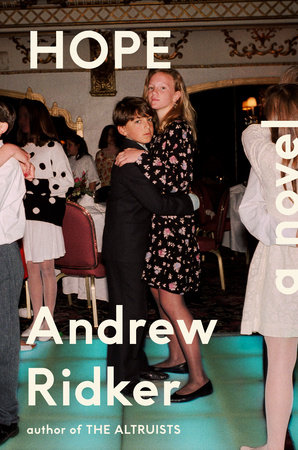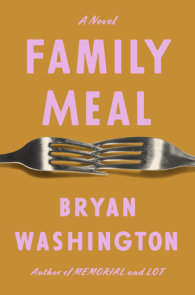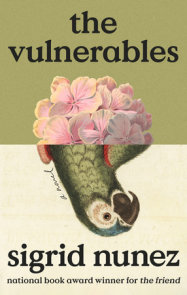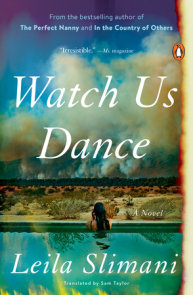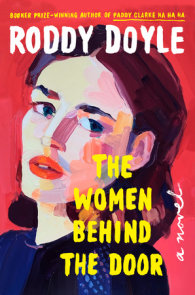READERS GUIDE
Introduction
A CONVERSATION WITH ANDREW RIDKERHope follows the four members of the Greenspan family over one tumultuous year. What was it like to inhabit the perspective of each of these characters? Did one voice come to you first?
One of the joys of writing, for me, is the opportunity to inhabit characters unlike myself. That’s why I fell in love with reading in the first place. The novel is the only form of technology I know of that can make a person feel, for an extended period, what it’s like to live as someone else. With that said, my characters don’t appear out of thin air. They’re often formed from the raw material of my life, even if their final shapes don’t much resemble me. Inhabiting them means drawing on, and reconstituting, certain facets of my personality, and then placing those characters in situations that both demonstrate and undermine my sense of who they are—and, consequently, who I am.
The primary challenge of writing from different points of view is that the protagonist of one section necessarily becomes a secondary character in others. Take Deb for example. In her section, we see the world through her eyes, to some degree. We have access to her thoughts, feelings, and opinions. But her daughter, Maya, doesn’t see her in quite the same way she sees herself, as we learn in Maya’s section. That goes for Deb’s husband and son, too. In that sense, there are four different Debs in the novel: Deb as she sees herself, and Deb as she is seen by the three other members of her family. This multiplying effect holds true for the other characters, of course. I set out to write a novel with four characters, and wound up having to write, in a sense, sixteen. (Do I have that right? Math was never my strongest subject. That’s why I’m a novelist and not a CPA.)
The benefit to this approach is that, ideally, readers get a multifaceted view of each character. What’s more, they have the chance to see the same incident from different points of view, calling into question the notion of a single, definitive account. This, to me, is what it feels like to be in a family, when multiple and often contradictory truths exist under a single roof.
How do the Greenspans’ values—their upper-class liberal sensibilities, their belief in meritocracy, their sense of earned exceptionalism—affect their relationships, both within the family and beyond? As a writer, how did you reconcile the values the Greenspans purport to hold with their actions?
In 1972, Richard Nixon cruised to reelection, winning every state but one: Massachusetts. In the aftermath of the election, a bumper sticker began appearing on cars along Route 128, the golden lasso encircling Boston’s most progressive and prosperous suburbs: “Don’t Blame Me,” the bumper sticker read, “I’m from Massachusetts.” That slogan encapsulates the Greenspans’ worldview, an exceptionalism that dates back to the Puritan notion of Boston as a “city on a hill.”
There’s something to be said for that worldview. If everyone in America shared the Greenspans’ priorities—“tolerance, beauty, and open-mindedness,” as the urban historian Lily Geismer described the values of Boston’s streetcar suburbs—the country would undoubtedly be a more peaceful place. (Just imagine if McGovern had won in ’72!) But such a country can’t exist, because those values are the product of that particular place. A single mother living in Dorchester or Roxbury might be less inclined to celebrate the virtues of our “meritocracy” than an affluent professional family in Brookline or Newton. It’s comforting to think the game is fair when you’ve already won.
If exceptionalism can breed contempt for others—the phrase “don’t blame me” suggests that someone else is, in fact, at fault—it also sets an unreasonably high bar for the exceptional. Many of the Greenspans’ problems stem from the pressure they place on themselves, and on one another, to achieve—financially, ethically, professionally. After all, if you think the game is fair and you don’t succeed, there’s nowhere to lay the blame except at your own feet.
I was raised on the same values that Scott and Deb inculcate in their children, so I try not to judge my characters for failing to live up to the expectations they set for themselves (and for one another). In other words, the Greenspans’ failings are my own. No one acts in accordance with their values all the time, least of all me. Writing Hope was, in part, an exercise in understanding the limitations of those values—which seemed to be the nation’s values in the 2010s, at least in blue states—from the vantage point of our tumultuous present.
The novel is set mostly in an upper middle class suburban American town in 2013. Would you talk about what it was like to write about that era, a time that is both recent, while being an entirely different political and cultural context? Why did you choose to set the novel in 2013? Did you have any new insights about politics, past or present, during the writing process?
Hope grew out of a different novel I was working on, which was set in the aftermath of the 2016 election. I wanted to take a long, hard look at the people who, like me, hadn’t seen Trump coming. I started scribbling notes about Brookline, the left-leaning suburb where I had come of age during Barack Obama’s presidency—a time and place where the prevailing mood, in light of what was to come later, could best be described as smug optimism.
In a world that changes as rapidly as ours, all fiction is historical fiction. But unlike more distant historical eras, which come with baggage in the form of familiar tropes, the recent past is uncharted territory. To situate myself in time and place, I created a cultural matrix, a document mapping the cultural landscape of the early 2010s. It helped, for example, to remind myself that 2013 was the year Lean In was published, or that we were only just beginning to hear about ISIS in 2014.
The central tension I discovered in compiling the matrix was an atmosphere of overwhelming optimism punctuated by major crises, some violent, none of which were enough to kill the mood. To set the scene: the big network TV shows were feel-good comedies like Modern Family and Parks and Recreation. Websites like Buzzfeed and Upworthy pumped positivity into our feeds. Inspirational viral videos (Batkid, Kony 2012, the Ice Bucket Challenge) circulated widely, as did dance crazes like “Gangnam Style” and “The Harlem Shake.” Hamilton was taking off. And 2013 saw the arrival of two royal babies: Prince George of Wales and North West of Los Angeles. But the cracks were beginning to show. Polar vortexes, the Cosby scandal, Ferguson, Ebola, the Boston Marathon bombing . . . Looking back, those crises seem less like anomalies than signs of what was come.
While Deb Greenspan is working with her synagogue to help resettle a Syrian family fleeing war, her son, Gideon, somewhat spontaneously goes on a Birthright-type trip to Israel, and he finds himself deeper into conflict territory than he and readers might have expected. Is it fair to say that Deb and Gideon represent two generations of the American Jewish experience?
A lot has changed in the ways that Jews are perceived, and perceive themselves, over the past fifty years. According to the most recent Pew report, conducted in 2020, “Jews are far less religious than American adults as a whole.” Only twenty percent of American Jews attend synagogue at least once per month, a figure that is virtually nonexistent for “Jews of no religion,” who comprise more than a quarter of the American Jewish population. Six out of ten Jews who married in the past decade have a non-Jewish spouse, a figure that has risen steadily since the 1980s.
Of course, there is more to being Jewish than attending synagogue or marrying another member of the tribe. (As a secular Jew who married a lapsed Catholic, I should know.) But there was one section of the Pew report that stood out to me. The survey asked American Jews to rate ten different attributes and activities as either essential, important but not essential, or not important to their sense of Jewish identity. Of the top five attributes/activities most commonly cited as essential, only the first, “remembering the Holocaust,” could be described as particularly and uniquely Jewish (76 percent of respondents marked it “essential”). Essential attributes/activities two through five are universal, the kinds of values taught at any public school in America: “leading an ethical and moral life” (72 percent), “working for justice and equality in society” (59 percent), “being intellectually curious” (56 percent), and “continuing family traditions” (51 percent). “Caring about Israel” clocks in at number six (45 percent), above more particular (if less “essential”) traits such as eating traditional Jewish foods (20 percent) and observing Jewish law (15 percent). These statistics beg the question: Absent religious or cultural observance, what, exactly, does it mean to be Jewish?
For Deb, a regular Reform synagogue-goer, being Jewish means embracing those universalist values of justice and equality, intellectual curiosity, and family tradition. (Preparing her mother’s gefilte fish recipe is of particular importance to her.) But her son, Gideon, has grown up with the confusion that the Pew statistics suggest. He’s Jewish—that much he knows is true—but he doesn’t believe in God or attend synagogue with any regularity. Like many young American Jews curious about their heritage, he turns to Israel, embarking on a state-sponsored tour that he hopes will help answer some of the lingering questions he has about himself. It isn’t a spoiler to say that the country supplies him more questions than answers.
I wouldn’t say he and Deb represent different generations of the American Jewish experience—there is no single monolithic experience, after all—but I think it’s fair to say that both Deb and Gideon are responding differently to the question of what it means to be Jewish in America today.
Maya Greenspan has an affair with her high school English teacher. In recent years, we’ve seen many uncomfortable, often toxic relationships between older men and younger women depicted in fiction. What did you want to explore through Maya’s encounters with her teacher, both when she is a high school student and when she is a young woman, having graduated from college and now in the working world?
It’s absolutely the case that we’ve been reassessing and reckoning with relationship dynamics like those in recent years. At the same time, no two relationships are alike; life, like good fiction, resists generalities. In the section spanning Maya’s time in high school, I was most interested in exploring the nonsexual, or extra-sexual, motivations informing her attraction to her teacher William, which is one reason they don’t sleep together until many years later. Any teenager can understand those motivations, especially the desire to rebel against one’s parents, and the complex interplay of dependence and independence that defines the life of a seventeen-year-old on the cusp of adulthood.
I was also interested in exploring the contours of teacher-student dynamics, which are especially intense at that age. William represents a version of adulthood that is entirely different from the one she’s been exposed to by her parents. At the same time, he is acting in loco parentis—almost literally, as he comes to fill a void left by Maya’s increasingly distant mother, who has her own troubles.
But what interested me above all was the way in which our stories can be appropriated without our permission. Years later, as an adult, Maya discovers that William has written a version of “her” story, which he has fictionalized in certain ways. That story is then picked apart by her colleagues in publishing, who take the “Maya” character to be a passive victim, which isn’t how Maya sees herself. William romanticizes their relationship, while her colleagues conscript her into a familiar narrative of abuse that doesn’t quite fit. In both cases, she’s denied agency, which she reclaims at the end of the novel by embarking on a writing project of her own.
What inspired you to write Hope? Do you think the Obama-era optimism that has long seemed intrinsic to the American attitude has fundamentally changed?
Hope is my way of making sense of the recent past—an attempt to understand the world today by taking a hard look at yesterday. The novel looks at America in the early 2010s through the prism of the Greenspan family, whose lives intersect with various pillars of society: education (Maya’s affair with her high school English teacher; Joan’s charter school drama); medicine (Scott’s medical fraud); the arts (Deb’s former dance career; Maya’s job in publishing); and the military/foreign policy (Gideon’s adventures in the Middle East). It’s fitting that the novel will be published during Joe Biden’s presidency, at a time when Americans have been forced to reckon with all that was great and not so great about the Obama era.
I don’t think it’s possible to be as starry-eyed about America as many of us were in the early 2010s. But that’s not necessarily a bad thing. The past few years have been marked by turmoil—far too much, to be sure—but some degree of disillusionment and discomfort is healthy, even necessary, if we’re ever going to fix the underlying problems in our country. In my view, the Greenspans are stronger at the end of the novel than they were at the beginning, but that strength comes at the cost of a very disruptive and chaotic year.
QUESTIONS AND TOPICS FOR DISCUSSION
1. Why do you think the novel is called Hope? How do you think the characters embody this ethos? What are the benefits and dangers of hope? What is your own relationship with hope?
2. The novel is set in 2013, during Obama’s second term. How did it feel to read about this era? What elements of the novel felt most distinctly historic?
3. Scott, Deb, Maya, and Gideon are all searching for meaning in modern, secular America—through work, romance, family, and community engagement. Do you think they find the purpose they seek? What, if anything, do you think the novel is illuminating about connection and interdependence?
4. What do you think causes Gideon to suddenly abandon his career in medicine? Do you admire the way he radically alters his life, politics, and relationships in Israel and Syria, and what do you think prompted these decisions—external events or internal emotions? Do you think his actions are a product of his upbringing, a reaction to twenty-first century America, or born of his own individual motivations?
5. After a few tough breaks, Scott starts to question his belief in the relationship between hard work and upward mobility. Deb, Maya, and Gideon become similarly disillusioned by the meritocracy they once trusted. Do you relate to the disillusionment they experience? What do you think takes the place of idealism?
6. The Greenspans are high-achieving, well-educated, and successful—admired in their community. As their family begins to unravel, so do the stories that upheld them for so long. What are some of the stories you tell about your own life and country? Have they changed in recent years?
7. Looking back on your own life during 2013, is there anything you wish you had known about the sociopolitical future just around the corner? What would you have done differently if you knew how rapidly our landscape would change?
8. How do Maya’s and Gideon’s relationships with their parents develop over the course of the novel? Did your feelings about the characters change?
9. Discuss the role of Judaism in the novel. How does it factor into the Greenspans’ lives and identities? In a community like Brookline, do you think people derive their values from religion, from politics, from class, or from something else? What about in your own life?
10. There is much humor in Hope, as well as pain and heartache. How did you feel about this balance? What effect did the more satirical passages have on your reading experience?







